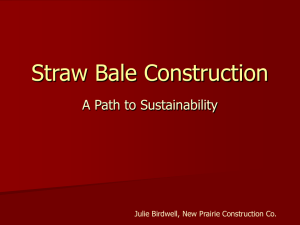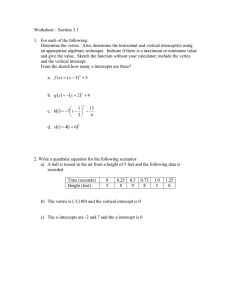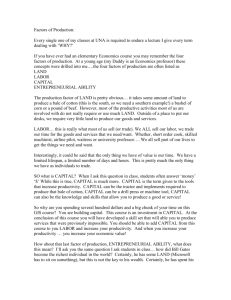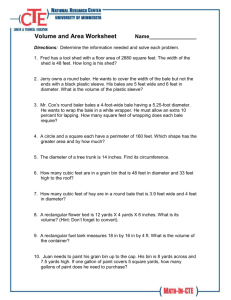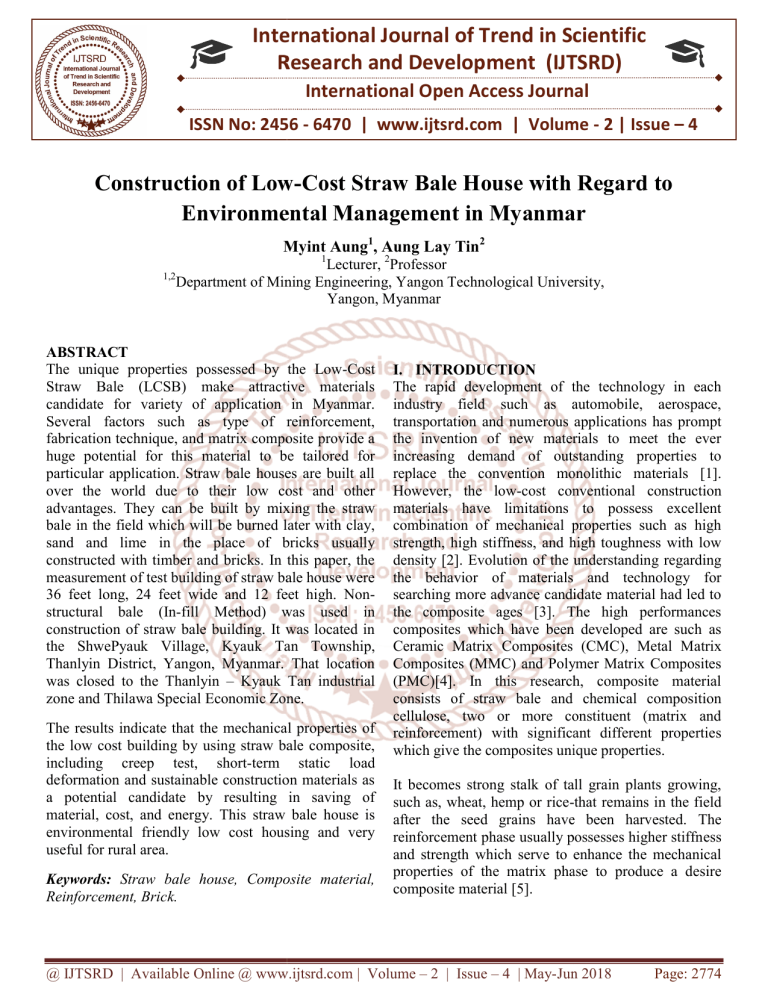
International Journal of Trend in Scientific
Research and Development (IJTSRD)
International Open Access Journal
ISSN No: 2456 - 6470 | www.ijtsrd.com | Volume - 2 | Issue – 4
Construction of Low
Low-Cost
Cost Straw Bale House with Regard to
Environmental Management in Myanmar
Myint Aung1, Aung Lay Tin2
1
1,2
Lecturer, 2Professor
Department of Mining Engineering, Y
Yangon
angon Technological University,
Yangon, Myanmar
ABSTRACT
The unique properties possessed by the Low
Low-Cost
Straw Bale (LCSB) make attractive materials
candidate for variety of application in Myanmar.
Several factors such as type of reinforcement,
fabrication technique, and matrix composite provide a
huge potential for this material to be tailored for
particular application. Straw bale houses are built all
over the world due to their low cost and other
advantages. They can be built by mixing the straw
bale in the
he field which will be burned later with clay,
sand and lime in the place of bricks usually
constructed with timber and bricks. In this paper, the
measurement of test building of straw bale house were
36 feet long, 24 feet wide and 12 feet high. Non
Nonstructural bale (In-fill
fill Method) was used in
construction of straw bale building. It was located in
the ShwePyauk Village, Kyauk Tan Township,
Thanlyin District, Yangon, Myanmar. That location
was closed to the Thanlyin – Kyauk Tan industrial
zone and Thilawa Special
ecial Economic Zone.
The results indicate that the mechanical properties of
the low cost building by using straw bale composite,
including creep test, short-term
term static load
deformation and sustainable construction materials as
a potential candidate by resulting
sulting in saving of
material, cost, and energy. This straw bale house is
environmental friendly low cost housing and very
useful for rural area.
Keywords: Straw bale house, Composite material,
Reinforcement, Brick.
I. INTRODUCTION
The rapid development of the technology in each
industry field such as automobile, aerospace,
transportation and numerous applications has prompt
the invention of new materials to meet the ever
increasing demand of outstanding properties to
replace the convention
nvention monolithic materials [1].
However, the low-cost
cost conventional construction
materials have limitations to possess excellent
combination of mechanical properties such as high
strength, high stiffness, and high toughness with low
density [2]. Evolution
n of the understanding regarding
the behavior of materials and technology for
searching more advance candidate material had led to
the composite ages [3]. The high performances
composites which have been developed are such as
Ceramic Matrix Composites (CMC),
(CMC Metal Matrix
Composites (MMC) and Polymer Matrix Composites
(PMC)[4]. In this research, composite material
consists of straw bale and chemical composition
cellulose, two or more constituent (matrix and
reinforcement) with significant different properties
propertie
which give the composites unique properties.
It becomes strong stalk of tall grain plants growing,
such as, wheat, hemp or rice--that remains in the field
after the seed grains have been harvested. The
reinforcement phase usually possesses higher stiffness
stiffn
and strength which serve to enhance the mechanical
properties of the matrix phase to produce a desire
composite material [5].
@ IJTSRD | Available Online @ www.ijtsrd.com | Volume – 2 | Issue – 4 | May-Jun
Jun 2018
Page: 2774
International Journal of Trend in Scientific Research and Development (IJTSRD) ISSN: 2456-6470
The objectives of the present work are to investigate
the environmental friendly low cost housing plan for
rural area and sustainable mechanical properties of
composite low-cost straw bale houses.
The structures of this study are as follow: Section II
presented method of analysis for straw bale house.
Results and discussions are indicated in Section III. In
Section IV, how to construct the straw bale house and
conclusions are presented in Section V.
II. METHODS OF ANALYSIS
A. Composite Straw Bale House
The use of plastered based straw bale building is one
of the finest renewable materials replacements. It is
strong stalk of tall grain plants – such as wheat, rye,
hemp or rice. Straw is one of that remains in the field
after the seed grains have been harvested. Its chemical
composition is primarily cellulose, just like trees.
When bundled into a bale it becomes a solid block
that is highly resistant to decomposition. When
covered with a plaster skin, strong, energy efficient
and ecologically sound house.
panels was measured periodically for up to standard
period 74 days.
2. Static Load Test
All five wall panels were examined for the static
loading in vertical compression. Constant loading was
applied incrementally through two five tons hydraulic
jacks for the failure components (Figure 3). The
applied load was recorded using five tons digital load
cells. The load was transferred directly to the straw
bales through the timber wall transferred directly to
the straw bales through the timber was plate. Figure 3
shows that the Vertical displacement of the straw
bales was recorded using two linear voltage
displacement transducers (LVDTs), placed centrally
across the width of the plate. Lateral buckling
displacements under loading were also recorded using
either LVDTs by direct taping measurement. The
average increment rate of loading for the failure
position was between 0.30 and 0.73kN/min. In
between each increment lateral displacement was
measured by taping and noting the general condition
of the wall.
B. Bailing Methods
There are two methods in bailing straw. These are two
stringers and three stringers methods. Two stringers
are roughly 18 inches wide, 14 inches high and 36
inches long and three stringers are roughly 24 inches
wide, 16 inches high and 48 inches long as shown in
Figure 1.
Fig. 2 Settlement test set up Fig. 3Static Load Test
Fig. 1 Types of Straw Bailing
3. Construction Methods of Straw Bale Building
Wall
There are three main methods to build with straw bale
such as structural bale (Nebraska-style), Light-weight
frame and non-structural bale (in-fill method) as
shown in Figure 4.
Both types of bailing were used in this test straw bale
house. After making bundle of straw bale, mechanical
testing was tested.
C. Testing of Mechanical Properties
1. Creep Test
In preparation for static testing to failure two of the
test walls were subject to a dead loading of 16.6
kN/m2, In that Figure 1, Vertical settlement of the
Fig. 4 Methods of straw bale construction
@ IJTSRD | Available Online @ www.ijtsrd.com | Volume – 2 | Issue – 4 | May-Jun 2018
Page: 2775
International Journal of Trend in Scientific Research and Development (IJTSRD) ISSN: 2456-6470
Among the straw bale construction methods, nonstructural bale (in-fill method) is used because of easy
to build and greater stability for window and door
frame than load bearing style.
III. RESULTS AND DISCUSSIONS
1. Creep Test Results
In the beginning of the test, the load was increased in
three stages. Initially a load of 330 kg was applied,
followed by a further 300 kg after 13 days and a
further 210 kg after 20 days. On application of each
load there was an instantaneous deformation. During
application of each load increment the instantaneous
stiffness of the bale wall did not significantly vary
(15-19 kN/mm). Following each load increment
settlement increased under constant loading, through
the rate of settlement gain generally decreased with
time. The greatest rate of settlement was recorded
during the first two days after load application,
thereafter slowing down to an average of between 0.2
and 0.9 mm/day. On removal of the load after 70 days
there was an instant recovery of 22 mm, followed by
further 10 mm over the following 4 days, by which
time the test was terminated. There was subsequently
tested under short-term static loading to failure. In the
second test, a total service loading of 840 kg was
applied in one increment. The initial stiffness of the
wall, 17 kN/mm, was similar to the first test wall
response. As before the deformation increased with
time. The greatest rate of creep deformation was also
recorded during the first two days after loading and
thereafter the rate of settlement wad approximately
0.5 mm/day over the following three weeks.
Settlement of the wall had not ceased after 23 days
when the test was ended. Figure 5 shows that load
settlement tests, the wall was subsequently strapped
with polypropylene strapping and lime rendered
before load testing failure.
one side arising from unequal deformation of the
upper-most bale, most likely caused by inconsistent
bale density. The recorded creep behavior described
above is also likely to have been influenced by
variations in the temperature and humidity conditions
in the laboratory temperature varied between 10˚C
and 23˚C during testing, relatives humidity varied
approximately between 30% and 70%.
2. Static Load Test Results
The short-term static load-deformation responses of
the test walls were shown in Figure 6.
Fig.6 Static Load Tests
Table 1 shows the summarizing of initial wall
stiffness, maximum applied loads and total
settlements. Initial was stiffness was recorded by the
recorded total settlement under a service load of 9.5
kN (19.2 kN/m2). The load reduction recorded in
some walls at each increment occurred during
measurement of lateral displacement and inspection of
the wall.
Figure 7 shows all unplastered walls failed by overall
buckling, though variations in bale density, especially
in the upper most bale, led to significant unequal
compression of the top plate in a number of tests (see
in Figure 8). Recorded deformation in Figure 4 and
5represent averaged values. In General, the stiffness
decreased as their maximum load approached and the
walls buckled in compression.
Fig.5 Load Settlement Test
The deformation presented a represent average
settlement of the wall. For example, in the second
wall the settlement was approximately 50% greater on
Fig.7 Buckling
Failure
Fig.8Rotation of
Well Plate
@ IJTSRD | Available Online @ www.ijtsrd.com | Volume – 2 | Issue – 4 | May-Jun 2018
Page: 2776
International Journal of Trend in Scientific Research and Development (IJTSRD) ISSN: 2456-6470
The standard bale construction wall settled under load
increasing with little change in stiffness until a
maximum load of 27.6 kN was reached. As expected
the initially pre- compressed wall exhibited increasing
stiffness compared to the standard construction as
shown in Table 1. Though the maximum load was
reduced although higher than both the half bale and
no hazed wall tests.
TABLE1. Static Load test results
Initial
Settlement
Maximum
wall
at
Wall
applied
stiffness
maximum
load(KN)
(KN/mm)
load (mm)
Standard
0.11
27.6
220
construction
Precompressed
0.22
19.2
120
wall
Half-bales
0.087
10.9
140
No hazel
0.077
11.7
165
spikes
Lime
rendered
5.62
41.1
55
wall
The wall built with half bales showed a significant
reduction in maximum load and initial stiffness. The
half bales were not as dense as the original bales and
the inclusion of vertical joints in alternative courses
was also expected to impair stiffness and strength.
Table 1 presents the condition of the maximum
applied load on the wall. Removal of hazel spikes
from wall construction had a significant impact on
both wall stiffness and load capacity. Hazel spikes
contribute to wall resistance to friction force which
passes through the bales, evident by the difficulty in
driving them during construction.
The addition of render or plaster coats to straw bale
changes mechanical properties. The mush stiffer and
stronger render outer coats attract a much greater
proportion of the vertical loading, resulting in a more
complex composite sandwich form of construction.
The involving of render coats of the strength and
stiffness of straw bale wall had shown significant
consequences for the construction and maintenance of
render coats.
The maximum loads and initial stiffness of the walls
were comparable reported with previous report (1,2).
The maximum loads for unplastered straw bale walls
were reported at between 4.2 and 19.2 kN/m2,
depending on bale type, orientation and the use of
internal reinforcing bars. Maximum load of
unplastered walls were reported with variation from
72 to 198 mm. For the maximum loads for plastered
bale walls were reported variation from 21 to 66
kN/m2.
A maximum permissible service load of
approximately 19 kN/m2(9.6 kN) was used in straw
bale wall design. The maximum applied load of the
lime rendered wall was over four times greater.
However, the maximum load of one unplastered wall
was only 13% higher, though the standard bale wall
achieved a maximums loading nearly three times
higher.
3. Failure Results
Lime rendering of the wall had greatest on strength
and stiffness. Initial stiffness was increased by over
50 times and maximum applied load by nearly 50 %.
Stiffness of the wall under load decreased noticeably
at around 15 kN as the lime rendered cracked and the
wall is failed. In Figure 9, though the lime render was
applied to the straw bales outside the full width of the
top bearing plate, a slight bearing of the top plate onto
the edge of the render of one side resulted in unequal
settlement of the top plate contributing to the
observed failure mode. Local buckling of the plaster,
bearing failure of the plaster was also observed.
Fig. 9 Lime rendered wall failure
IV.CONSTRUCTION OF TEST STRAW BALE
HOUSES
After testing foe mechanical properties of straw bale,
test building was built in selected site. The following
Figures were shown for construction procedures of
test building.
@ IJTSRD | Available Online @ www.ijtsrd.com | Volume – 2 | Issue – 4 | May-Jun 2018
Page: 2777
International Journal of Trend in Scientific Research and Development (IJTSRD) ISSN: 2456-6470
(e)Plastering in (1:3) Lime Mortar
(f)Ceiling and Painting
(a) Practical Straw Bailing
(b) Construction of Foundation
(g)Vegetation of Surround of Building
© Fixing of Post and C.G.I Sheet Roofing
Fig. 10 Step by Step of Construction for Straw Bale
House
After construction of straw bale house, indoor and
outdoor temperature are measured during summer and
winter seasons. This results show that straw bale
house is colder than brick noggin in summer season
and warmer than in winter season. Cost of straw bale
house and 4 ½” thick brick noggin was estimated for
comparison. The following Table 2 shows the
comparison between 4 ½” thick brick noggin walling
and 12” thick straw bale walling. It can be found that
cost of straw bale house is less than twice of brick
nogging walling.
(d)Construction of Straw Bale Walling and Fixing of
Windows Frames
@ IJTSRD | Available Online @ www.ijtsrd.com | Volume – 2 | Issue – 4 | May-Jun 2018
Page: 2778
International Journal of Trend in Scientific Research and Development (IJTSRD) ISSN: 2456-6470
Table2. Comparison between 4½" Thick Brick NoggingWalling and 12" Thick Strawbale Walling
Type
Particular
Material ,
Labour
Total
Cost (Ks) Cost (Ks) Cost (Ks)
(A)
(B)
4 ½" Thick Brick Nogging
Waling in Cement Mortar 1:3
12" Thick Strawbale Block
Walling with Sq.mesh
Defference
V. CONCLUSIONS
Finally, the conclusion for this paper are (a) reducing
the carbon emission due to the reduction of the
cement using (b) studying of the mechanical
behaviour of the materials which depend on the
design of the wall making (c) saving the
environmental effect.
Therefore, this straw bale house is environmental
friendly low cost building and very useful for rural
area.
ACKNOWLEDGEMENT
The author would like to deeply thank to Professor
Dr.MyoNyunt, Head, Department of Mining
Engineering, Technological University, Monywa for
his keeping encouraging to produce this paper. And
87875
44000
131875
43600
21000
64600
44275
23000
67275
also, thanks to Dr.KyawSwar Tint, Professor,
Department of Mining Engineering and Dr. Aung Lay
Tin, Professor and Head, Department of Mining
Engineering, Yangon Technological University.
REFERENCES
1. K.sheprd, “Straw Bale Home Basics” Boulder
Company, USA, 2006.
2. Mohamed Salah GharibElsayed, “Straw Bale is
Future House Building Material”, Egypt, 2006.
3. C. Keefe, “Straw Bale Design-Choosing the Right
Size Straw Bales”, 2007.
4. Dr. MyoNyunt, “Building construction by using
Straw Bale”, Myanmar Engineering Society,
Tech- Digest, October, 2010.
@ IJTSRD | Available Online @ www.ijtsrd.com | Volume – 2 | Issue – 4 | May-Jun 2018
Page: 2779

